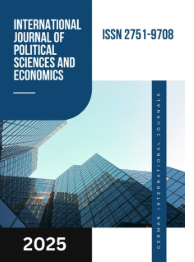RECOMBINATION MECHANISMS IN GALLIUM ARSENIDE (GAAS) SEMICONDUCTORS
DOI:
https://doi.org/10.55640/Keywords:
Gallium Arsenide (GaAs), III-V semiconductors, recombination mechanisms, radiative recombination, non-radiative recombination, auger recombination, defects in semiconductors, direct bandgap materials, optoelectronic devices.Abstract
This paper explores the recombination mechanisms in III-V group semiconductors, focusing specifically on Gallium Arsenide (GaAs) and Indium Phosphide (InP). These materials are widely used in optoelectronic devices due to their direct bandgap and high electron mobility. The study discusses different types of recombination processes including radiative, non-radiative, and Auger recombination, and analyzes their dependence on factors such as temperature, doping level, and crystal defects. A comparative analysis between GaAs and InP is presented to highlight their performance in various applications such as LEDs, lasers, and high-efficiency solar cells. Understanding the recombination dynamics in these semiconductors is crucial for improving the efficiency and reliability of modern electronic and photonic devices.
References
1. Sze, S. M., and Ng, K. K. (2006). Physics of Semiconductor Devices (3rd ed.). Wiley-Interscience.
2. Streetman, B. G., and Banerjee, S. (2015). Solid State Electronic Devices (7th ed.). Pearson.
3. Blakemore, J. S. (1982). Gallium Arsenide: Fundamental Properties and Use as a Semiconductor. Journal of Applied Physics, 53(10), R123-R181.
4. Adachi, S. (1992). Physical Properties of III–V Semiconductor Compounds. Wiley-Interscience.
5. Nelson, J. (2003). The Physics of Solar Cells. Imperial College Press.
6. Razeghi, M. (2009). Fundamentals of Solid State Engineering (3rd ed.). Springer.
7. Morkoç, H. (2008). Handbook of Nitride Semiconductors and Devices. Wiley-VCH.
8. Casey, H. C., and Panish, M. B. (1978). Heterostructure Lasers: Part A. Academic Press.
9. Shockley, W., and Read, W. T. (1952). Statistics of the Recombinations of Holes and Electrons. Physical Review, 87(5), 835.
10. Hall, R. N. (1952). Electron-Hole Recombination in Germanium. Physical Review, 87(2), 387.
11. Henry, C. H., and Lang, D. V. (1977). Nonradiative capture and recombination by multiphonon emission in GaAs and GaP. Physical Review B, 15(2), 989.
12. Blood, P., and Orton, J. W. (1992). The Electrical Characterization of Semiconductors: Majority Carriers and Electron States. Academic Press.
13. Reggiani, L. (Ed.). (1985). Hot-Electron Transport in Semiconductors. Springer.
14. Piprek, J. (2003). Optoelectronic Devices: Advanced Simulation and Analysis. Springer.
15. Jain, S. C., Willander, M., Narayan, J., & Overstraeten, R. V. (2000). III–V nitrides: Growth, characterization, and properties. Journal of Applied Physics, 87(3), 965–1006.
Downloads
Published
Issue
Section
License

This work is licensed under a Creative Commons Attribution 4.0 International License.
Authors retain the copyright of their manuscripts, and all Open Access articles are disseminated under the terms of the Creative Commons Attribution License 4.0 (CC-BY), which licenses unrestricted use, distribution, and reproduction in any medium, provided that the original work is appropriately cited. The use of general descriptive names, trade names, trademarks, and so forth in this publication, even if not specifically identified, does not imply that these names are not protected by the relevant laws and regulations.







